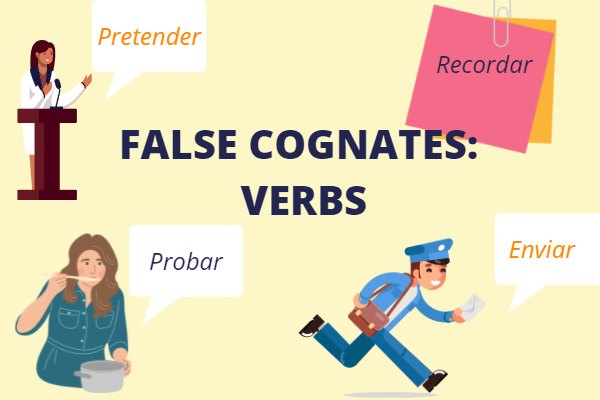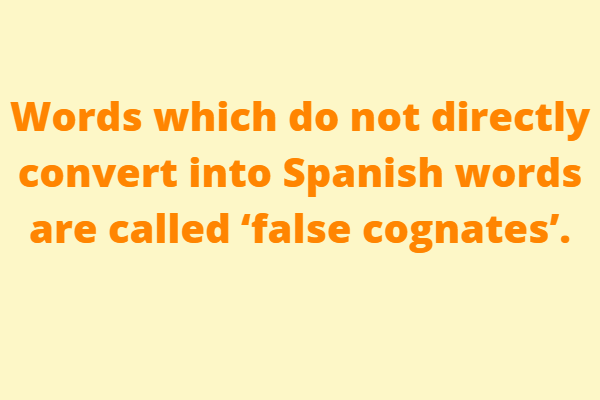10 Common Spanish Verb False Cognates
What are ‘cognates’ and ‘false cognates’?
Cognates
Although Spanish can be a challenging language to learn, in fact it shares many words with English. These shared words are called ‘cognates’. They have similar spellings and meanings in both languages with the differences being more in the pronunciations (pronunciaciones). One of the best tricks in the book when you get stuck on a word in Spanish is to let yourself assume (assumir) the word you’re searching for is a cognate. In this case, you can simply add a Spanish language accent, add an ‘o’ or ‘a’ at the end and more times than not, you will have the correct or almost correct word in Spanish! ¡Correcto!
Here are a couple examples of Spanish and English language cognates:
Fruit = fruta
You want to let the fruit seller know you would like some fruit. You know the word quiero (I want) but you don’t know the word for ‘fruit’. Just change your accent, add an ‘a’ and there you go!
Quiero fruta por favor.
I’d like some fruit please.
The fruit seller will take things from there.
Car = carro
You would like to know if someone has a car. Again, you know the word amiga (friend) and your color gris (gray) but don’t know the word for car. Just change your accent, add the ‘o’ on the end, and voilá! there you have it.
El carro de mi amiga es de color gris.
My friend’s car is gray.
And with that statement you’ll have others to help you find your friend’s car (carro) in that big parking lot.
The ‘-tion’ and ‘-ly’ ending tips
There are a couple of crucial tips that are life-saving when learning Spanish. If you learn these cognate secrets, you will increase your Spanish vocabulary 100-fold!
-tion endings ⇨ -ción endings
One of the best cognates to learn is that many of the English words ending in ‘-tion’ are directly transferable to Spanish by just changing your accent and the ‘-tion’ to a ‘-ción’ /si-un/.
Necesito más información.
I need more information.
Este programa tiene mucha acción.
This program has a lot of action.
-ly endings ⇨ -mente endings
Another incredible cognate trick is that many of the English words ending in ‘-ly’ are directly transferable to Spanish by just changing your accent and the ‘-ly’ to ‘-mente’ /men-tae/ or -amente /ah men tae/.
Él contestó perfectamente.
He answered perfectly.
Finalmente llegó.
He finally arrived.
Unfortunately, those tricks will not always prove to be successful as not all words are cognates. Even the best of us have fallen into situations where our cognate guessing attempts fail and something completely (completamente) random is said which will leave the listener looking a bit confused. But never let those confusions discourage you!
False Cognates
A false cognate is a word that is spelled almost exactly (exactamente) the same in both languages, however the meanings are completely different.
Here is a list of 10 of the most common false cognate Spanish verbs. Keep reading as they just might save you from a possibly (posiblemente) confusing or embarazada (oops!) I mean, embarrassing, conversation (conversación). But again, always try guessing cognates and don’t be afraid of making blunders. The more you blunder, the more you learn.
Here is our list of the 10 most common false cognate verbs in the Spanish language:
Pretender ≠ pretend
pretender = to try / intend
El gobernador pretende minimizar el crimen organizado.
The governor tries to reduce organized crime.
Presumir ≠ presume
presumir = to show off
A Carlos le gusta presumir su carro nuevo.
Carlos likes to show off his car.
Realizar ≠ realize
realizar = to finish or accomplish something
Mi hermana pudo realizar sus sueños.
My sister was able to accomplish her dreams.
Embarazar ≠ embarrass
Embarazar = to impregnate
The verb, embarazar, is usually used in either the reflexive:
embarazarse meaning ‘to get pregnant’
or in the past participle:
Estar embarazada meaning ‘to be pregnant’.
Julia se embarazó en su luna de miel.
Julia got pregnant on her honeymoon.
Julia está embarazada!
Julie is pregnant!
Enviar ≠ envy
enviar = to send
Siempre envió cartas postales a mis amigos.
I always send postcards to my friends.
Recordar ≠ record
recordar = to remember
No puedo recordar las fechas históricas.
I can’t remember historic dates.
Probar ≠ probe
probar = to try
Me encanta probar nuevos guisos.
I love trying* new dishes.
Molestar ≠ molest
molestar = to bother / annoy / irritate
¡Deje de molestarme!
Stop bothering me!
Asistir ≠ assist
asistir = to attend
No sé si voy a asistir a la reunión.
I don’t know if I’m going to attend the meeting.
Atender ≠ attend
atender = take care of / tend to / deal with
La familia tiene que atender a sus abuelitos.
The family has to take care of their grandparents.
*Wondering why we used the ‘-ing- ending here? Check out our blog on gerunds.
We hope these tips continue to help you grow and advance in your Spanish language learning!
Read here to learn more false cognates or check out our other blogs where you’ll learn more grammar, vocabulary and basic Spanish language tips.
Are you ready to take your learning even further? Sign up for our professional and personalized one-to-one online classes or come down to fully immerse yourself in an authentic Mexican city off the beaten path.


